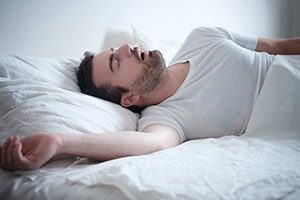 Every man, woman and child requires sleep. Its purpose is somewhat unknown, except that it seems to allow our body and mind to regenerate and recharge. Each person varies in the amount of sleep required and many chemicals, such as caffeine and nicotine, can affect the quality of sleep. The body cycles through different stages of sleep from light, transitional non-REM sleep to deep sleep to rapid eye movement (REM) sleep. There are many consequences of not getting the proper amount or quality of sleep during the night. These include dozing off at inappropriate times of the day, higher risk of car accidents, and lower pain threshold/tolerance.
Every man, woman and child requires sleep. Its purpose is somewhat unknown, except that it seems to allow our body and mind to regenerate and recharge. Each person varies in the amount of sleep required and many chemicals, such as caffeine and nicotine, can affect the quality of sleep. The body cycles through different stages of sleep from light, transitional non-REM sleep to deep sleep to rapid eye movement (REM) sleep. There are many consequences of not getting the proper amount or quality of sleep during the night. These include dozing off at inappropriate times of the day, higher risk of car accidents, and lower pain threshold/tolerance.
There are several different disorders that could affect the sleep a person is able to get, including obstructive sleep apnea (OSA), insomnia, and parasomnia to name a few. Obstructive sleep apnea (OSA) is defined as the repetitive reduction or cessation of nasal-oral airflow due to partial or total occlusion of the upper airway during sleep. It affects about 1 in 30 Americans and is increasing due to the increasing incidence of obesity, a known risk factor. Snoring is considered a risk factor as well. It is said, however, that not everyone who snores has sleep apnea, but nearly everyone with OSA snores. Other risk factors include certain anatomical features (ex. neck size), age, male predilection (2:1), sleep position, race and family history. Common symptoms are snoring, witnessed breathing pauses, daytime sleepiness, and morning headaches. A diagnosis is usually made after examination and sleep study by a sleep physician. During the sleep study, they measure the disruptions in breathing and correlating disruptions in the sleep cycle along with oxygen saturation levels.
Besides daytime sleepiness and problems sleeping with bed partners, there are many health consequences of not treating OSA. It is associated with an increased incidence of hypertension, congestive heart failure, diabetes mellitis, atrial fibrillation, myocardial infarction (heart attack), stroke, and dementia in women. Other negative outcomes of not treating include higher incidence of workplace and motor vehicle accidents, depression, loss of memory, and decrease in sexual vitality. During the night, the intermittent lack of oxygen causes a sympathetic response from the nervous system, causing the body to release epinephrine, which causes the heart to work overtime. Over time, this can actually increase the risk of premature death!
OSA can be treated many times with the use of continuous positive airway pressure, or CPAP for short. This involves wearing a mask that uses air under pressure to basically form an airway stent during the night blowing excess tissue away. Many people however can not tolerate a CPAP appliance, due to clogged nose, mask issues, dry mouth, insomnia, or simply taking it off during the night. There is another treatment available as an alternative to CPAP that we as dentists can provide and this is a mandibular repositioning device (MRD). It is an oral appliance that holds the lower jaw forward and works by increasing the upper airway volume and resting tonicity of the tongue. Studies have shown similar rates of effectiveness between oral appliances and CPAP and patients generally prefer oral appliances.
If you think you may have sleep apnea or have already been diagnosed and think you may benefit from an oral appliance, make sure to talk to your dentist and ask them if they treat OSA in their office. A dentist is an important member of an interdisciplinary team in the treatment of sleep apnea. Your health and quality of life will increase and you will never regret it.
